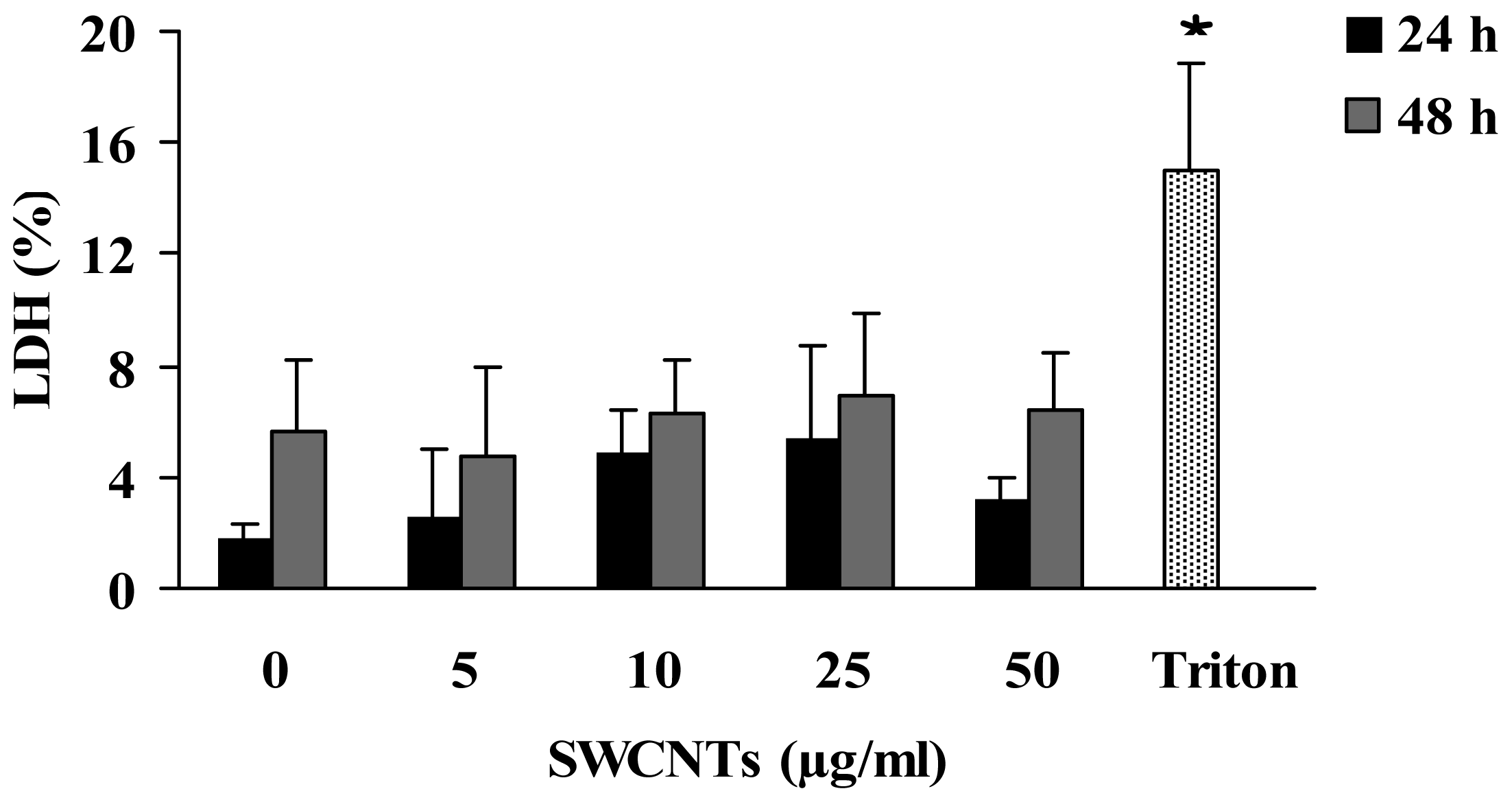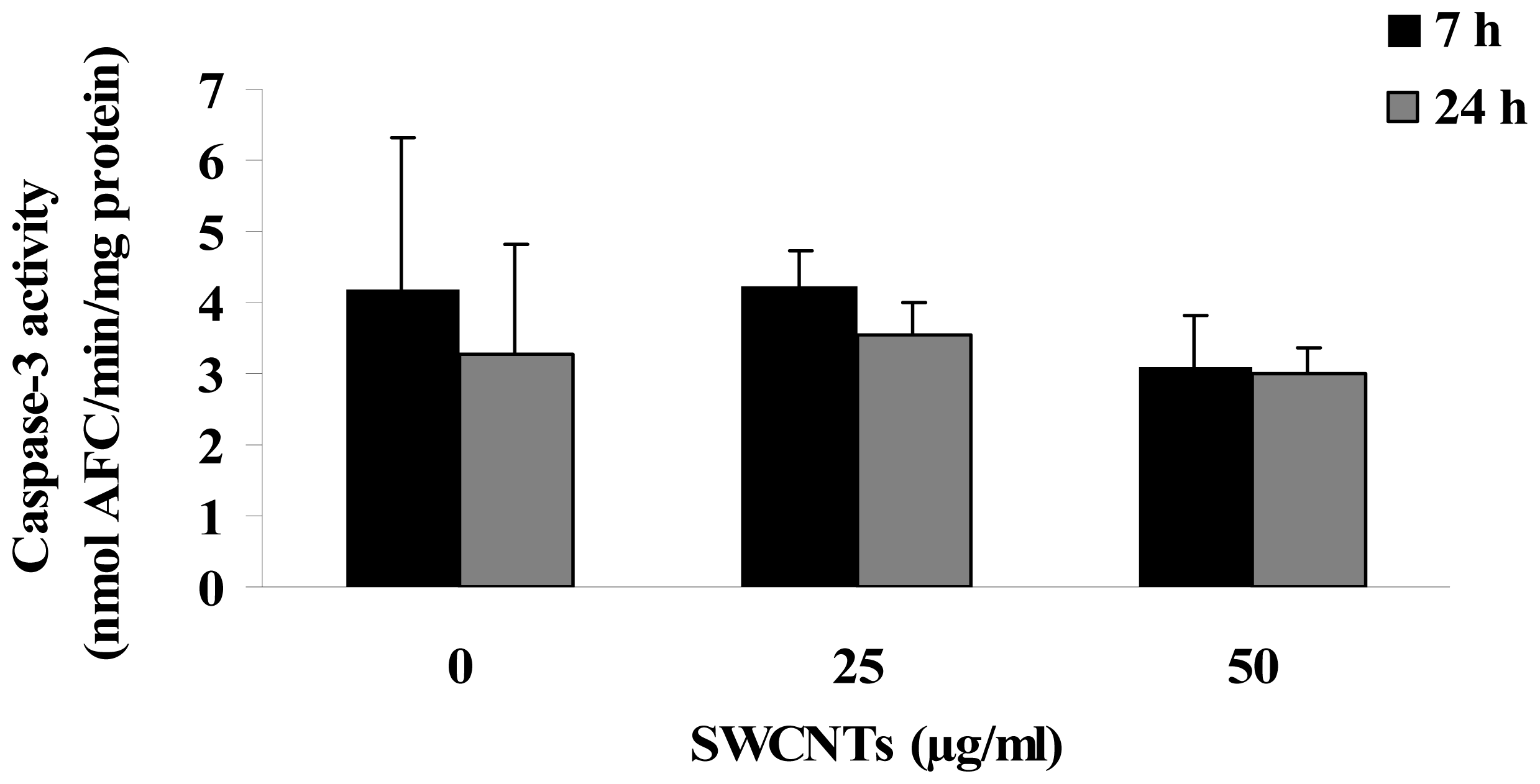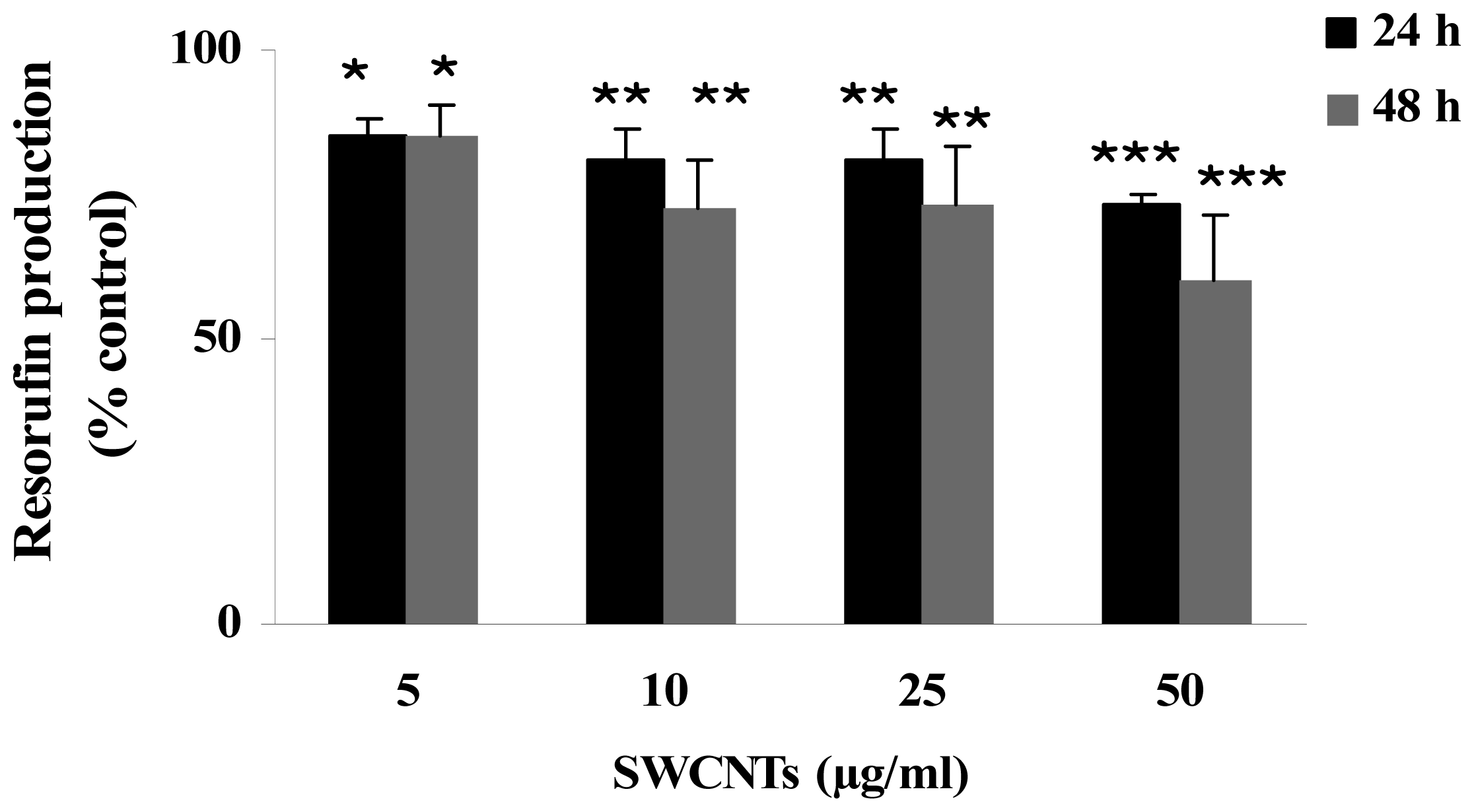Cytotoxicity Investigation on Cultured Human Blood Cells Treated with Single-Wall Carbon Nanotubes
Abstract
:1. Introduction
2. Material and Methods
2.1 Reagents
2.2 Nanotubes characteristics and preparation
2.3 Lymphocytes isolation and culturing
2.4 Trypan-blue exclusion method
2.5 Lactate dehydrogenase
2.6 Caspase-3 activity assay
2.7 Resazurin assay
2.8 Alkaline comet assay
2.9 Data analysis
3. Results and Discussion
4. Conclusions
Acknowledgments
References and Notes
- Lin, Y.; Taylor, S.; Li, H.; Fernando, S.K.A.; Qu, L.; Wang, W.; Gu, L.; Zhou, B.; Sun, YP. Advances towards bioapplications of carbon nanotubes. J. Mater. Chem. 2004, 14, 527–541. [Google Scholar]
- Hurt, R.H.; Monthioux, M.; Kane, A. Toxicology of carbon nanomaterials: status, trends, and perspectives on the special issue. Carbon 2006, 44, 1028–1033. [Google Scholar]
- Smart, S.K.; Cassady, A.I.; Lu, G.Q.; Martin, D.J. The biocompatibility of carbon nanotubes. Carbon 2006, 44, 1034–1047. [Google Scholar]
- Shvedova, A.; Castranova, V.; Kisin, E.; Schwegler-Berry, D.; Murray, A.; Gandelsman, V.; Maynard, A.; Baron, P. Exposure to nanotube material: assessment of nanotube cytotoxicity using human keratinocyte cells. J. Toxicol. Environ. Health. 2003, 66, 1901–1918. [Google Scholar]
- Monteiro-Riviere, N.A.; Nemanich, R.J.; Inman, A.O.; Wang, Y.Y.; Riviere, J.E. Multi-walled carbon nanotube interactions with human epidermal keratinocytes. Toxicol. Lett. 2005, 155, 377–384. [Google Scholar]
- Manna, S.K.; Sarkar, S.; Barr, J.; Wisw, K.; Barrera, E.V.; Jejelowo, O.; Rice-Ficht, A.C.; Ramesh, J.T. Single-walled carbon nanotubes induces oxidative stress and activates nuclear transcription factor-kB in human keratinocytes. Nano Lett. 2005, 5, 1676–1684. [Google Scholar]
- Jia, G.; Wang, H.; Yan, L.; Wang, X.; Pei, R.; Yan, T.; Zhao, Y.; Guo, X. Cytotoxicity of carbon nanomaterials: single-wall nanotubes, multiwall nanotube, and fullerene. Environ. Sci. Technol. 2005, 39, 1378–1383. [Google Scholar]
- Ding, L.; Stilwell, J.; Zhang, T.; Elboudwarej, O.; Jang, H.; Selegue, J.P.; Cooke, P.A.; Gray, J.W.; Chen, F.F. Molecular characterization of the cytotoxic mechanism of multiwall carbon nanotubes and nano-onions on human skin fibroblast. Nano Lett. 2005, 5, 2448–2464. [Google Scholar]
- Muller, J.; Huaux, F.; Moreau, N.; Misson, P.; Heilier, J.F.; Delos, M.; Arras, M.; Fonseca, A.; Nagy, J.B.; Lison, D. Respiratory toxicity of multi-wall carbon nanotubes. Toxicol. Appl. Pharmacol. 2005, 207, 221–231. [Google Scholar]
- Bottini, M.; Bruckner, S.; Nika, K.; Bottini, N.; Bellocci, S.; Magrini, A.; Bergamaschi, A.; Mustelin, T. Multi-walled carbon nanotubes induce T lymphocyte apoptosis. Toxicol. Lett. 2006, 160, 121–126. [Google Scholar]
- Boyum, A. Isolation of leukocytes from human blood. Further observations. Methylcellulose, dextran and ficoll as erythrocyte aggregation agents. Scand. J. Clin. Lab. Invest. 1968, 97, 31–50. [Google Scholar]
- Decker, T.; Lohmann-Matthes, M.L. A quick and simple method for the quantitation of lactate dehydrogenase release in measurements of cellular cytotoxicity and tumour necrosis factor (TNF) activity. J. Immunol. Methods 1988, 115, 61–69. [Google Scholar]
- Russo, M.; Palumbo, R.; Mupo, A.; Tosto, M.; Iacomino, G.; Scognamiglio, A.; Tedesco, I.; Galano, G.; Russo, G.L. Flavonoid quercetin sensitizes a CD95 resistant cell line to apoptosis by activating protein kinase Cα. Oncogene 2003, 22, 3330–3342. [Google Scholar]
- O'Brien, J.; Wilson, I.; Orton, T.; Pognan, F. Investigation of the Alamar blue (resazurin) fluorescent dye for the assessment of mammalian cell cytotoxicity. Eur. J. Biochem. 2000, 267, 5421–5426. [Google Scholar]
- Singh, N.P.; McCoy, M.T.; Tice, R.; Schneider, E.L. A simple technique for quantitation of low level of DNA damage in individual cells. Exp. Cell. Res. 1988, 175, 184–187. [Google Scholar]
- Zeni, O.; Gallerano, G.P.; Perrotta, A.; Romanò, M.; Sannino, A.; Sarti, M.; D'Arienzo, M.; Doria, A.; Giovenale, E.; Lai, A.; Messina, G.; Scarfì, M.R. Cytogenetic observations in human peripheral blood leukocytes following in vitro exposure to THz radiation: a pilot study. Health Phys. 2007, 92, 349–357. [Google Scholar]
- Riedl, S.J; Shi, Y. Molecular mechanisms of caspase regulation during apoptosis. Nat. Rev. Mol. Cell Biol. 2004, 5, 897–907. [Google Scholar]
- Zhang, H.X.; Du, G.H.; Zhang, J.T. Assay of mitochondrial functions by resazurin in vitro. Acta Pharmacol. Sin. 2004, 25, 385–389. [Google Scholar]
- Davoren, M.; Herzog, E.; Casey, A.; Cottineau, B.; Chambers, G.; Byrne, H.J.; Lyng, F.M. In vitro toxicity evaluation of single walled carbon nanotubes on human A549 lung cells. Toxicol In Vitro 2007, 21, 438–448. [Google Scholar]
- Worle-Knirsch, J.M.; Pulskamp, K.; Krug, H.F. Oops they did it again! Carbon nanotubes hoax scientists in viability assays. Nano Lett. 2006, 6, 1261–1268. [Google Scholar]
- Monteiro-Riviere, N.A.; Inman, A.O. Challenger for assessing carbon nanomaterial toxicity to the skin. Carbon 2006, 44, 1070–1078. [Google Scholar]
- Casey, A.; Herzog, E.; Davoren, M.; Lyng, F.M.; Byrne, H.J.; Chambers, G. Spectroscopic analysis confirms the interactions between single walled carbon nanotubes and various dye commonly used to assess cytotoxicity. Carbon 2007, 45, 1425–1432. [Google Scholar]
- Burlinson, B.; Tice, R.R.; Speit, G.; Agurell, E.; Brendler, S.Y.; Collins, A.R.; Escobar, P.; Honma, M.; Kumaravel, T.S.; Nakajima, M.; Sasaki, Y.F.; Thybaud, V.; Uno, Y.; Vasquez, M.; Hartmann, A. Fourth international workgroup on genotoxicity testing: results of the in vivo comet assay workshop. Mutat. Res. 2007, 627, 31–35. [Google Scholar]
- Fairbairn, D.W.; Olive, P.L.; O'Neill, K.L. The comet assay: a comprehensive review. Mutat. Res. 1995, 339, 37–59. [Google Scholar]
- Rojas, E.; Lopez, M.C.; Malverde, M. Single cell gel electrophoresis assay: methodology and applications. J. Chromatogr. 1999, 722, 225–254. [Google Scholar]
- Wick, P.; Manser, P.; Limbach, L.K.; Dettlaff-Weglikowska, U.; Krumeich, F.; Roth, S.; Stark, W.J.; Bruinink, A. The degree and kind of agglomeration affect carbon nanotube cytotoxicity. Toxicol. Lett. 2007, 168, 121–131. [Google Scholar]
- Magrez, A.; Kasa, S.; Salicio, V.; Pasquier, N.; Seo, J.W.; Celio, M.; Catsicas, S.; Schwallrer, B.; Forro, L. Cellular toxicity of carbon-based nanomaterilas. Nano Lett. 2006, 6, 1121–1125. [Google Scholar]
- Cui, D.; Tian, F.; Ozkan, C.S.; Wang, M.; Gao, H. Effect of single wall carbon nanotubes on human HEK293 cells. Toxicol. Lett. 2005, 155, 73–85. [Google Scholar]
- Pulskamp, K.; Diabate, S.; Krug, H.F. Carbon nanotubes show no sign of acute toxicity but induce intracellular reactive oxygen species in dependence on contaminants. Toxico. Lett. 2007, 168, 58–74. [Google Scholar]
- Garibaldi, S.; Brunelli, C.; Bavastrello, V.; Ghigliotti, G.; Nicolini, C. Carbon nanotube biocompatibility with cardiac muscle cells. Nanotechnology 2006, 17, 391–397. [Google Scholar]




| Treatment | Migrated DNA (%) | Tail length (microns) | Tail moment (arbitrary units) |
|---|---|---|---|
| Control | 1.62±0.76 | 3.49±1.72 | 0.45±0.30 |
| CNTs- 1 μg/ml | 1.52±1.20 | 3.20±1.60 | 0.46±0.44 |
| CNTs- 5 μg/ml | 1.94±1.07 | 3.69±1.63 | 0.67±0.41 |
| CNTs - 10 μg/ml | 1.60±0.68 | 3.34±1.14 | 0.45±0.23 |
| MMS - 150 μM | 14.92±1.16* | 19.28±1.61* | 5.44±0.61* |
© 2008 by MDPI Reproduction is permitted for noncommercial purposes.
Share and Cite
Zeni, O.; Palumbo, R.; Bernini, R.; Zeni, L.; Sarti, M.; Scarfì, M.R. Cytotoxicity Investigation on Cultured Human Blood Cells Treated with Single-Wall Carbon Nanotubes. Sensors 2008, 8, 488-499. https://doi.org/10.3390/s8010488
Zeni O, Palumbo R, Bernini R, Zeni L, Sarti M, Scarfì MR. Cytotoxicity Investigation on Cultured Human Blood Cells Treated with Single-Wall Carbon Nanotubes. Sensors. 2008; 8(1):488-499. https://doi.org/10.3390/s8010488
Chicago/Turabian StyleZeni, Olga, Rosanna Palumbo, Romeo Bernini, Luigi Zeni, Maurizio Sarti, and Maria Rosaria Scarfì. 2008. "Cytotoxicity Investigation on Cultured Human Blood Cells Treated with Single-Wall Carbon Nanotubes" Sensors 8, no. 1: 488-499. https://doi.org/10.3390/s8010488





